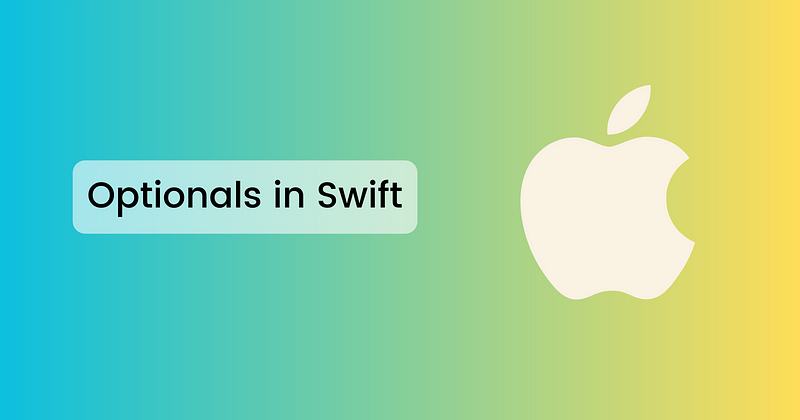Understanding Optionals in Swift: A Comprehensive Guide
Written on
Chapter 1: Introduction to Optionals
In programming, particularly in languages such as Swift and Kotlin, the concept of optionals plays a crucial role in avoiding null pointer exceptions and ensuring safer management of nullable values.

The main objective of optionals is to enhance code reliability by clearly indicating the possibility of absent values, which significantly lowers the risk of runtime failures caused by null pointer exceptions.
Section 1.1: Defining Nil in Swift
Swift distinctly differentiates between “no value” and all other values. The term for “no value” is nil, which is fundamentally different from other data types. When you want a variable to potentially hold no value, you define it as an optional.
Only optional variables can be assigned the nil value. If a variable is not designated as optional, it cannot be set to nil:
var aNonOptionalInteger = 42 // Standard variable, cannot be nil
aNonOptionalInteger = nil // ERROR: only optional values can be nil
You can determine if an optional variable has a value by employing an if statement. However, be cautious: unwrapping an optional that lacks a value will trigger a runtime error and crash your application.
Section 1.2: Unwrapping Optionals
To access the value within an optional, you must “unwrap” it. There are several methods to accomplish this:
- Forced Unwrapping (!): This method is dangerous and should be avoided when possible, as it will cause a runtime crash if the optional is nil.
- Optional Binding (if let or guard let): This approach safely checks for a value in the optional and binds it to a temporary variable within the scope of the conditional block.
- Nil Coalescing (??): This operator provides a default value when the optional is nil, allowing for graceful handling of absent values.
- Optional Chaining: This enables you to call methods, access properties, or index an optional if it is not nil, stopping execution if the optional is nil.
var name: String? // Declare an optional String variable
name = "John" // Assign a value to the optional
// Forced Unwrapping (risky, can lead to a crash if nil)
let unwrappedName = name!
print("Name: (unwrappedName)")
// Optional Binding (safe way to unwrap)
if let safeName = name {
print("Safe Name: (safeName)")
} else {
print("Name is nil")
}
// Nil Coalescing (provides a default value)
let displayName = name ?? "Unknown"
print("Display Name: (displayName)")
Section 1.3: Implicitly Unwrapped Optionals
Implicitly unwrapped optionals, denoted as String!, may contain a value or be nil, but do not require checks before use. This is useful when you are certain that an optional will always hold a value. In Swift, you declare such an optional using an exclamation mark (!) following the type, indicating it will be automatically unwrapped upon access.
var age: Int! // Declare an implicitly unwrapped optional
age = 25
// Automatically unwrapped when accessed
let unwrappedAge = age
print("Age: (unwrappedAge)")
Chapter 2: Working with Optional Types
Not all types can be optional. Only classes, structs, and enums can be marked as optional, while primitive types like integers and booleans are non-optional by default.
Section 2.1: Optional Chaining
In many instances, using an if-let or checking if a value is nil may be unnecessary. In such cases, optional chaining serves as an alternative to unwrapping your optional variables. By using the ? operator after an optional variable, you can treat it as if it were non-optional. If nil is encountered, the operation will fail and return nil instead of causing a crash.
struct Person {
var name: String?
var address: Address?
}
struct Address {
var street: String?
var city: String?
}
let person: Person? = Person(name: "Alice", address: Address(street: "123 Main St", city: "Wonderland"))
// Optional Chaining to access nested properties
if let city = person?.address?.city {
print("City: (city)")
} else {
print("City not available")
}
Section 2.2: Using Map and FlatMap
Functional programming techniques such as map and flatMap can be applied to optionals, allowing for transformation of values within an optional or chaining multiple optionals together.
let optionalNumber: Int? = 5
// Using map to transform the optional value
let doubled = optionalNumber.map { $0 * 2 } // Result: Optional(10)
// Optional chaining with map
let tripled = optionalNumber.map { $0 * 3 } // Result: Optional(15)
// Using flatMap to chain optionals and unwrap
let optionalText: String? = "42"
let sum = optionalNumber.flatMap { num in
optionalText.flatMap { text in
Int(text).map { num + $0 }}
} // Result: Optional(47)
Conclusion: Minimizing Optionals
Whenever feasible, structure your code to reduce the reliance on optionals by providing default values, employing non-optional types, or implementing alternative strategies like error handling. The examples outlined above demonstrate various methods for managing optionals, including unwrapping, optional chaining, and using map/flatMap for transformations. Always prioritize safe unwrapping techniques to prevent crashes due to nil values.
Thank you for reading! If you found this article helpful, please share and show your support!